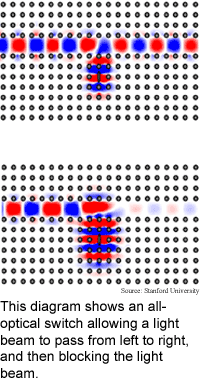
Switch promises optical chips
By
Eric Smalley,
Technology Research NewsOne way to make tomorrow's communications equipment considerably faster and cheaper is to make computer chips from optical switches that are tripped with the same type of light pulses that carry information over fiber-optic lines. Optical switches could also eventually find use as circuits in fast, all-optical computer chips.
Marrying optical switches and computer chips also promises to address a looming problem with electronic circuits: as electronic circuits get faster, the time it takes to shunt a signal from one part of a chip to another becomes a limiting factor. Using optical circuits to transmit signals between various parts of an otherwise electronic chip would sidestep the problem.
The challenges to putting optical switches on computer chips are making the switches small enough and finding ways to control them with light. Today's optical switches are controlled electrically.
Researchers from Stanford University and the Massachusetts Institute of Technology have taken a large step in this direction with designs for a simple optical switch and an optical transistor made from photonic crystal. The devices would be small, switched by light signals, would require little power, and could be fabricated in the same facilities used to make today's computer chips.
The researchers' transistor design is a few microns wide, and the switch design is smaller than a micron -- "far smaller than any conventional optical switching element [and] comparable to current electronic devices that perform the same functionality," said Mehmet Fatih Yanik, a researcher in the department of applied physics at Stanford University.
Key to both types of switches is the use of photonic crystal, a material made from tiny arrangements of rods or a solid material with patterns of holes. The boundaries between the medium and gaps refract, or bend, light. This is the same effect that produces the familiar illusion of a drinking straw bending at the air-liquid boundary.
The researchers' switches could be used as optical interconnects in future computer chips. They could also be used to construct all-optical circuits for use in a fast, inexpensive generation of optical communications equipment like routers and high-speed switches that control telecommunications networks.
The devices could be switched using only a few thousandths of a watt of power, allowing them to directly switch the low-power optical pulses that travel over conventional fiber-optic cable, said Yanik.
The switches' low-power requirements and small size make it possible to put many optical switching elements on a single chip. This would dramatically cut the cost of optical switching equipment and at the same time improve the equipment's information processing capabilities, said Yanick.
The researchers' simple switch design calls for a semiconductor-rod-based photonic crystal arranged to contain a waveguide situated near a tiny optical cavity. The waveguide is simply a row without rods. The optical cavity is an elliptical rod that is half the width and a little more than twice the length of a normal rod and is oriented perpendicular to the waveguide.
The optical cavity briefly stores light energy; this allows the device to act as a switch because the stored energy changes the angle of refraction, blocking light from moving through the adjacent waveguide. When the energy level in the cavity is low, it has little effect on the waveguide and a beam of light passes through unhindered.
Sending a pulse through the light beam in the waveguide increases the energy level in the cavity, turning the switch off. "The output of this device switches between near-perfect transmission to zero transmission digitally, like an electronic flip-flop [switch]," said Yanik.
Key to the design is that the structure of the photonic crystal enables a large amount of energy to build up in a very small space, even when the input power is low.
The researchers' transistor design consists of a pair of waveguides that intersect at right angles. A rod at the intersection of the waveguides produces the switching effect. In the same manner as an electronic transistor, a signal through one waveguide is blocked at the intersection until a signal passes through the other waveguide, which alters the optical properties of the intersection, allowing the first signal through.
The switch and transistor can be made in existing microchip fabrication facilities, said Yanik. It "does not require any complex processing... it can be readily fabricated with the same processing steps used in microchip fabrication," he said.
The researchers are now working on fabricating the transistor, said Yanik. "It might take about a year or so to experimentally demonstrate the first prototype," he said.
The method could be used to make practical on-chip all-optical information processing devices in two to five years, according to Yanik.
Yanik's research colleagues were Shanhui Fan of Stanford University and Marin Soljacic of MIT. The work appeared in the October 6, 2003 issue of Applied Physics Letters and the December 15, 2003 issue of Optics Letters. The research was funded by the National Science Foundation (NSF) and the Defense Advanced Research Projects Agency (DARPA).
Timeline: 2-5 years
Funding: Government
TRN Categories: Optical Computing, Optoelectronics and Photonics
Story Type: News
Related Elements: Technical papers, "High-Contrast All-Optical Bistable Switching in Photonic Crystal Microcavities," Applied Physics Letters, October 6, 2003; "All-Optical Transistor Action with Bistable Switching in a Photonic Crystal Cross-Waveguide Geometry," Optics Letters, December 15, 2003.
Advertisements:
November 19/26, 2003
Page One
Segway robot opens doors
Jolts turn liquid to solid
Switch promises optical chips
Physics tackles processor problem
Briefs:
Molecular memory is electric
Liquid crystal tunes fiber
Nanotubes fortify plastic film
Plastic display circuit shines
Model leverages nano tethers
Stamp forms organic laser

News:
Research News Roundup
Research Watch blog
Features:
View from the High Ground Q&A
How It Works
RSS Feeds:
News
Ad links:
Buy an ad link
| Advertisements:
|
 |
Ad links: Clear History
Buy an ad link
|
TRN
Newswire and Headline Feeds for Web sites
|
© Copyright Technology Research News, LLC 2000-2006. All rights reserved.